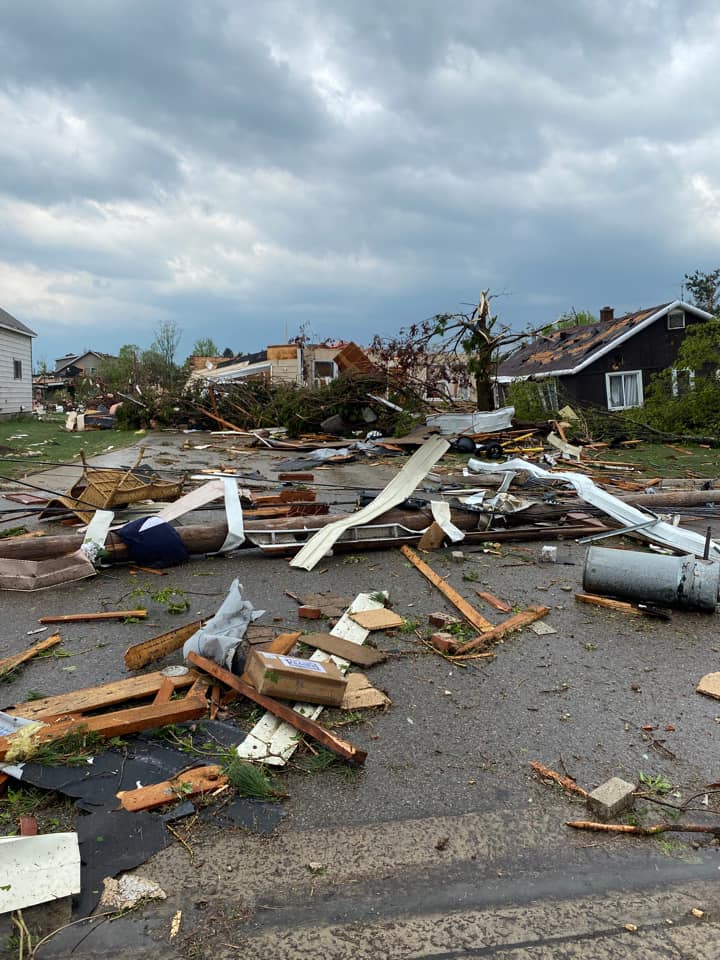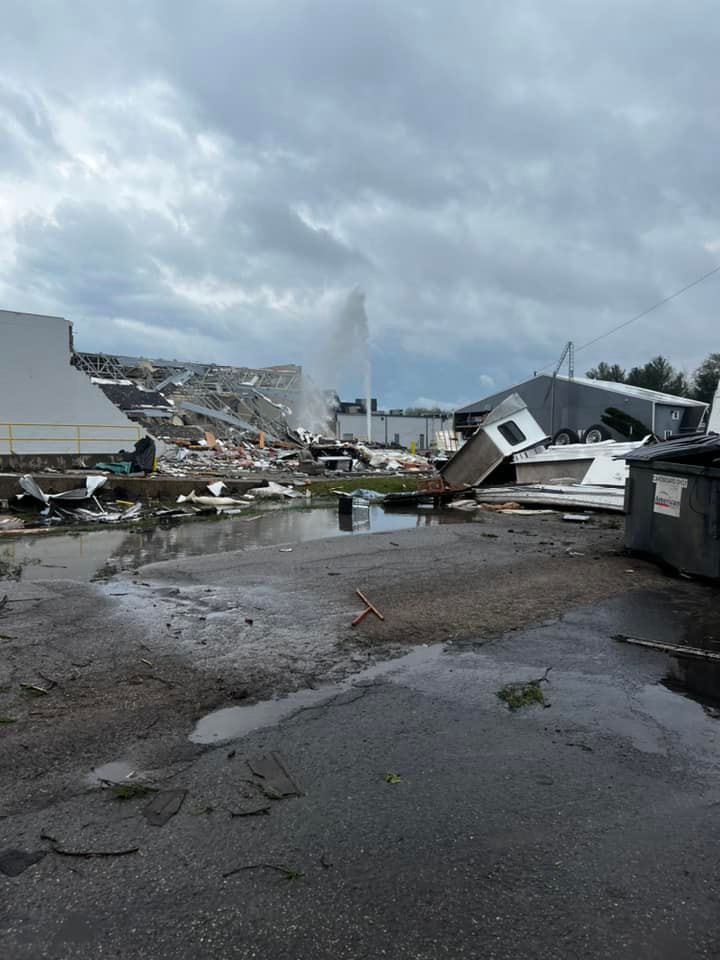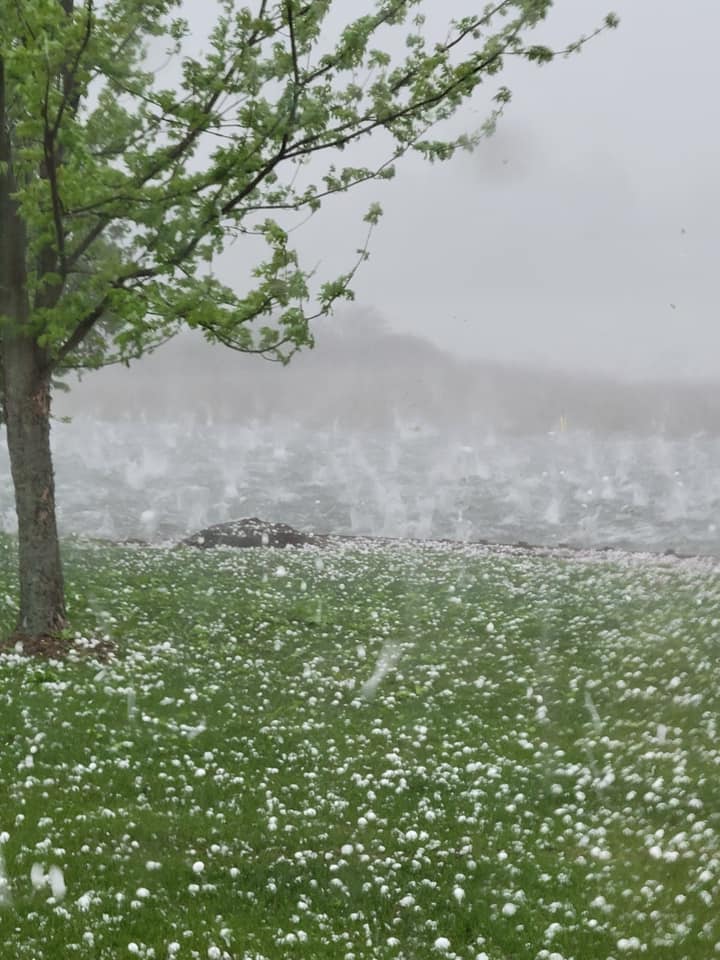Gaylord, MI
Weather Forecast Office
For a more in-depth view of the meteorology and damage behind the historic EF-3 Gaylord, MI tornado, visit this page.
Overview
Multiple thunderstorms tracked across northern Michigan during the afternoon, including a supercell thunderstorm that produced the tornado that hit the town of Gaylord along with very large hail in other parts of the area.
Setting the stage for severe weather was a trough that rotated across the upper Midwest that developed and strengthened surface low pressure west of Lake Michigan. This system helped draw a warm, moist airmass northward across the state that helped provide the instability necessary to support severe thunderstorms later in the day. Storms initially formed along the cold front across Wisconsin during the morning hours and moved northeast across Lake Michigan, making it into the forecast area by early afternoon. The strongest line segment generated a measured wind gust of 76 mph at Frankfort Light and continued to produce damaging wind gusts across Leelanau and Antrim counties as it quickly moved northeast.
As this segment moved further away from the cold front, it began to transition into a supercell thunderstorm. This storm moved east-northeast across a very favorable environment in place across northern lower Michigan, eventually producing a tornado that caused considerable damage in the city of Gaylord. This supercell continued to trek across the area, producing baseball-sized hail in Posen.
A special weather balloon launch was conducted at 3 PM EDT to get a better look at the environment in place ahead of the approaching storm. The data from this balloon launch displayed a rare environment in place that was supportive of storms producing damaging wind gusts, very large hail, and tornadoes. Specifically, the data showed ample instability in place. This is measured by a variable called Convective Available Potential Energy (CAPE), where values were near 2,000 Joules/kilogram. Very strong wind shear was also in place, which is a measure of the change in wind speed and direction with height in the atmosphere. Almost 60 knots of shear was measured from the surface to 6 km above ground level. Storm-relative helicity (SRH), a variable that shows the tendency of the air being drawn into the storm to spin, had values of almost 300 meters^2/second^2. The magnitude of all of these variables are very high, supportive for supercell thunderstorm development and severe weather. Additionally, it is very rare for this magnitude of all of these variables to come together at once across northern Michigan.
|
Tornado: Gaylord
|
||||||||||||||||
 |
 |
 |
 |
| Tornado damage in Gaylord- Photo credit Marcy Maciag Bancroft | Tornado damage in Gaylord at Hobby Lobby and Jimmy John's- Photo credit Arica Alread | Tornado damage in Gaylord at Goodwill- Photo credit Kyle Piers | Extensive damage at the Hobby Lobby in Gaylord- Photo credit Melissa Davison |
The Enhanced Fujita (EF) Scale classifies tornadoes into the following categories:
| EF0 Weak 65-85 mph |
EF1 Moderate 86-110 mph |
EF2 Significant 111-135 mph |
EF3 Severe 136-165 mph |
EF4 Extreme 166-200 mph |
EF5 Catastrophic 200+ mph |
 |
|||||
Hail:
Large hail accompanied these storms with the largest hail stones ranging from the size of quarters (1.00") to slightly larger than baseballs (3.00").
 |
 |
 |
 |
| Large hail in Elmira, Otsego County. Photo courtesy of Christopher Weber | Large Hail in Presque Isle County. Photo courtesy of Stephanie Adamski | Large Hail in Presque Isle County. Photo courtesy of Courtney Dege | Large hail in Hawks, Presque Isle County. Photo courtesy of Cheryl Blade |
 |
 |
 |
 |
| Large hail on Grand Lake, Presque Isle County. Photo courtesy of Mary Brunette Taglarini | Large hail in Presque Isle. Photo courtesy of Cassie Helms. | Large hail on Grand Lake, Presque Isle County. Photo courtesy of Mary Brunette Taglarini | Large hail in Grand Lake, Presque Isle County. Photo courtesy of Becky Meyer |
Radar:
KAPX Doppler Radar loop from 2:00 PM through 5:40 PM EDT on May 20th.
 |
Storm Reports
.png)
..TIME... ...EVENT... ...CITY LOCATION... ...LAT.LON... ..DATE... ....MAG.... ..COUNTY LOCATION..ST.. ...SOURCE.... ..REMARKS.. 0314 PM TSTM WND DMG CENTRAL LAKE 45.07N 85.26W 05/20/2022 ANTRIM MI PUBLIC SCANNER REPORTS CREWS ARE ON THE SCENE OF A TREE BLOCKING A ROADWAY NEAR CENTRAL LAKE. TIME ESTIMATED BY RADAR. 0316 PM TSTM WND DMG BELLAIRE 44.98N 85.21W 05/20/2022 ANTRIM MI PUBLIC REPORTS OF TREES AND WIRES DOWN IN BELLAIRE. TIME ESTIMATED FROM RADAR. 0337 PM HAIL 2 W ELMIRA 45.06N 84.89W 05/20/2022 E1.75 INCH ANTRIM MI PUBLIC FACEBOOK PHOTO OF GOLF BALL SIZED HAIL AT THE INTERSECTION OF M-32 AND US 131. TIME ESTIMATED BY RADAR. 0339 PM TSTM WND DMG 4 SSW ELMIRA 45.01N 84.87W 05/20/2022 ANTRIM MI PUBLIC SCANNER REPORTS TREES DOWN ON PATERSON ROAD NEAR ALBA HWY. POSSIBLE TORNADO. TIME ESTIMATED BY RADAR. 0339 PM HAIL ELMIRA 45.06N 84.85W 05/20/2022 E2.00 INCH OTSEGO MI PUBLIC FACEBOOK PHOTO OF A LARGE HAILSTONE IN ELMIRA. TIME ESTIMATED BY RADAR. 0348 PM TORNADO 2 W GAYLORD 45.03N 84.70W 05/20/2022 OTSEGO MI NWS EMPLOYEE TORNADO SPOTTED BY NWS EMPLOYEE NEAR THE INTERSECTION OF M-32 AND MURNER ROAD. 0353 PM TORNADO 2 W SPARR 45.04N 84.62W 05/20/2022 OTSEGO MI NWS EMPLOYEE TORNADO SPOTTED BY NWS EMPLOYEE 1 MILE E OF GAYLORD AT APPROXIMATELY 3:53PM. 0415 PM HAIL 4 N CLEAR LAKE STATE PA 45.20N 84.19W 05/20/2022 E1.50 INCH PRESQUE ISLE MI PUBLIC FACEBOOK PHOTO OF 1.50 INCH HAIL AT TOMAHAWK CREEK FLOODING. TIME ESTIMATED ON RADAR. 0438 PM HAIL HAWKS 45.30N 83.90W 05/20/2022 E2.00 INCH PRESQUE ISLE MI PUBLIC TIME ESTIMATED BY RADAR. 0445 PM HAIL POSEN 45.26N 83.70W 05/20/2022 E2.75 INCH PRESQUE ISLE MI PUBLIC BASEBALL SIZED HAIL REPORTED IN POSEN. 0457 PM HAIL 3 WNW PRESQUE ISLE 45.31N 83.52W 05/20/2022 E2.00 INCH PRESQUE ISLE MI PUBLIC REPORT OF HEN EGG SIZED HAIL IN BLACK BASS BAY. TIME ESTIMATED BY RADAR. 0230 PM TSTM WND DMG GLEN ARBOR 44.89N 85.99W 05/20/2022 LEELANAU MI LAW ENFORCEMENT COUNTY DISPATCH REPORTED TREE DOWN BLOCKING S. GLEN LAKE RD. TIME ESTIMATED VIA RADAR. 0235 PM TSTM WND DMG 3 SSE LELAND 44.98N 85.73W 05/20/2022 LEELANAU MI LAW ENFORCEMENT TREE DOWN BLOCKING POP RD. TIME ESTIMATED VIA RADAR. 0325 PM HAIL 4 W ALBA 44.98N 85.05W 05/20/2022 E1.00 INCH ANTRIM MI PUBLIC DELAYED REPORT OF 1IN HAIL 4MI WEST OF ALBA. 0345 PM HAIL 5 NW GAYLORD 45.09N 84.75W 05/20/2022 E1.00 INCH OTSEGO MI PUBLIC DELAYED REPORT... QUARTER SIZED HAIL 5MI NW OF GAYLORD. 0349 PM HAIL 2 E VANDERBILT 45.14N 84.63W 05/20/2022 E0.88 INCH OTSEGO MI PUBLIC DELAYED REPORT OF NICKEL SIZED HAIL IN CORWITH TWP VIA FACEBOOK. TIME ESTIMATED BY RADAR. 0358 PM HAIL HESSEL 46.01N 84.42W 05/20/2022 E1.75 INCH MACKINAC MI PUBLIC DELAYED REPORT OF GOLF BALL SIZED HAIL IN HESSEL. TIME ESTIMATED BY RADAR. 0450 PM HAIL 2 NNW PRESQUE ISLE 45.33N 83.49W 05/20/2022 E3.00 INCH PRESQUE ISLE MI PUBLIC DELAYED REPORT OF 3IN HAIL NEAR PRESQUE ISLE. 0229 PM TSTM WND GST 1 SW FRANKFORT 44.63N 86.25W 05/20/2022 M76 MPH LMZ346 MI MESONET MESONET STATION XFLT FRANKFORT LIGHT.
 |
Media use of NWS Web News Stories is encouraged! Please acknowledge the NWS as the source of any news information accessed from this site. |
 |
Local Information
Area Information
Office Webcam
Forecast
Recreational
Great Lakes/Marine
NWS DSS Table
Beach/Surf
Text Products
US Dept of Commerce
National Oceanic and Atmospheric Administration
National Weather Service
Gaylord, MI
8800 Passenheim Road
Gaylord, MI 49735-9454
989-731-3384
Comments? Questions? Please Contact Us.

